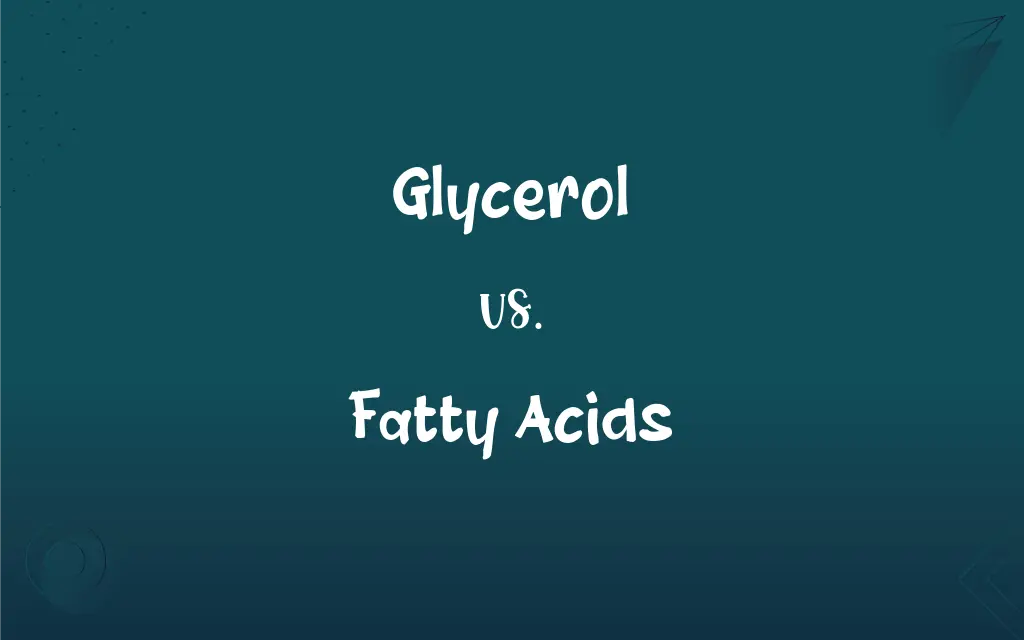Glycerol vs. Fatty Acids: What's the Difference?
Edited by Harlon Moss || By Janet White || Published on March 6, 2024
Glycerol is a three-carbon alcohol used in lipids, while fatty acids are long hydrocarbon chains with a carboxyl group, essential for energy and cell structure.

Key Differences
Glycerol serves as a backbone for triglycerides, connecting three fatty acid molecules through ester bonds. It is a polyol, characterized by its three hydroxyl (-OH) groups, making it highly soluble in water. Conversely, fatty acids consist of a carboxyl group attached to a long hydrocarbon chain, which can be saturated or unsaturated. These chains are hydrophobic, making fatty acids less soluble in water compared to glycerol.
Fatty acids and glycerol play crucial roles in metabolism and energy storage. Glycerol can be converted into glucose, providing energy for the body, while fatty acids are major components of lipids, crucial for storing energy, insulating and protecting organs. Despite their differences, both are integral to the structure and function of biological membranes.
In the synthesis of lipids, glycerol's versatility is evident as it forms the backbone for both fats and oils, depending on the nature of the fatty acids attached. Saturated fatty acids lead to solid fats at room temperature, while unsaturated fatty acids result in oils. This distinction highlights the different physical properties imparted by glycerol and fatty acids in biological molecules.
Chemically, glycerol and fatty acids exhibit distinct functional groups that define their reactions and biological functions. Glycerol's alcohol groups allow it to participate in dehydration synthesis reactions to form triglycerides, while the carboxyl group of fatty acids is reactive in various biochemical processes, including energy production and cellular signaling.
Despite their differences, glycerol and fatty acids are interconnected in lipid metabolism. The breakdown of triglycerides during lipolysis releases glycerol and fatty acids into the bloodstream, where they serve different but complementary roles in energy metabolism. This process underscores the essential nature of both molecules in physiological processes.
ADVERTISEMENT
Comparison Chart
Chemical Structure
Three-carbon alcohol with three hydroxyl groups
Long hydrocarbon chain with a terminal carboxyl group
Solubility in Water
High due to hydroxyl groups
Low due to long hydrocarbon chain
Physical State at RT
Typically a sweet, syrupy liquid
Solid or liquid depending on saturation
Role in Lipids
Backbone of triglycerides and phospholipids
Provide energy, insulation, and cellular structure
Metabolic Function
Can be converted to glucose for energy
Oxidized to produce energy or synthesize biomolecules
ADVERTISEMENT
Glycerol and Fatty Acids Definitions
Glycerol
"Glycerol can be used as an antifreeze agent."
Glycerol lowers the freezing point of water in winter car care products.
Fatty Acids
"Fatty acids can be saturated or unsaturated."
Olive oil is rich in oleic acid, a monounsaturated fatty acid.
Glycerol
"Glycerol is a key component of triglycerides in fats."
Breaking down dietary fats releases glycerol into the bloodstream.
Fatty Acids
"Fatty acids play a role in signaling and inflammation."
Arachidonic acid is involved in the production of inflammatory mediators.
Glycerol
"Glycerol is a simple polyol compound."
Glycerol is often added to foods as a sweetener and preservative.
Fatty Acids
"Fatty acids are essential for constructing cell membranes."
Omega-3 fatty acids contribute to brain health and function.
Glycerol
"Glycerol is used in pharmaceutical formulations."
Cough syrups utilize glycerol to improve texture and taste.
Fatty Acids
"Fatty acids serve as a concentrated energy source."
The body stores excess calories as fatty acids in adipose tissue.
Glycerol
"Glycerol serves as a moisturizing agent in cosmetics."
Lotions contain glycerol to help retain skin moisture.
Fatty Acids
"Fatty acids are carboxylic acids with long hydrocarbon chains."
Palmitic acid is a saturated fatty acid found in palm oil.
Glycerol
A syrupy, sweet, colorless or yellowish liquid triol, C3H8O3, obtained from fats and oils as a byproduct of saponification and used as a solvent, antifreeze, plasticizer, and sweetener and in the manufacture of dynamite, cosmetics, liquid soaps, inks, and lubricants.
Glycerol
(organic compound) 1,2,3-trihydroxy-propane or propan-1,2,3-triol; a trihydric alcohol
Glycerol
A syrupy sweet liquid obtained as a by-product in the manufacture of soap from animal or vegetable oils and fats; it is used as an antifreeze, a plasticizer, and a food sweetener and in the manufacture of dynamite, cosmetics etc.
Glycerol
Same as Glycerin.
Glycerol
A sweet syrupy trihydroxy alcohol obtained by saponification of fats and oils
FAQs
Can glycerol be converted into energy?
Yes, glycerol can be converted into glucose, providing energy for the body.
What role do fatty acids play in the body?
They are key for energy storage, cell membrane structure, and signaling.
What are fatty acids?
Fatty acids are long hydrocarbon chains with a carboxylic acid group at one end.
How are glycerol and fatty acids related?
They are components of triglycerides, with glycerol serving as the backbone to which fatty acids are attached.
Is glycerol soluble in water?
Yes, due to its hydroxyl groups, glycerol is highly soluble in water.
What is glycerol?
Glycerol is a three-carbon alcohol compound found in fats and oils.
What is the difference between glycerol and glycerin?
Glycerol and glycerin refer to the same molecule, though "glycerin" is often used in commercial products.
Can glycerol be used in biofuel?
Yes, glycerol is a byproduct of biodiesel production and can be used as a feedstock for biofuel.
How are triglycerides formed?
Triglycerides are formed by the esterification of glycerol with three fatty acids.
How do fatty acids affect health?
The balance of saturated and unsaturated fatty acids can impact cardiovascular and overall health.
Do fatty acids have vitamins?
Fatty acids themselves are not vitamins, but essential fatty acids are necessary for absorbing fat-soluble vitamins.
What is the significance of omega-3 fatty acids?
Omega-3 fatty acids are important for brain function and reducing inflammation.
How do trans fats affect fatty acid profiles?
Trans fats alter the fatty acid profile in the body, potentially increasing the risk of heart disease.
How do fatty acids influence inflammation?
Certain fatty acids can either promote or reduce inflammation through their metabolic pathways.
Are all fatty acids the same?
No, they can be saturated or unsaturated, affecting their physical properties and biological functions.
What is the role of glycerol in the skin?
Glycerol acts as a humectant, attracting water to the skin to maintain moisture.
What products contain glycerol?
Glycerol is found in foods, cosmetics, pharmaceuticals, and antifreeze solutions.
Can excess glycerol lead to weight gain?
While glycerol itself is not a major contributor to weight gain, excess caloric intake from any source can lead to fat storage.
Are there plant sources of glycerol and fatty acids?
Yes, both glycerol and fatty acids can be found in various plant oils and fats.
What makes fatty acids "essential"?
Essential fatty acids cannot be synthesized by the body and must be obtained from the diet.
About Author
Written by
Janet WhiteJanet White has been an esteemed writer and blogger for Difference Wiki. Holding a Master's degree in Science and Medical Journalism from the prestigious Boston University, she has consistently demonstrated her expertise and passion for her field. When she's not immersed in her work, Janet relishes her time exercising, delving into a good book, and cherishing moments with friends and family.
Edited by
Harlon MossHarlon is a seasoned quality moderator and accomplished content writer for Difference Wiki. An alumnus of the prestigious University of California, he earned his degree in Computer Science. Leveraging his academic background, Harlon brings a meticulous and informed perspective to his work, ensuring content accuracy and excellence.































































